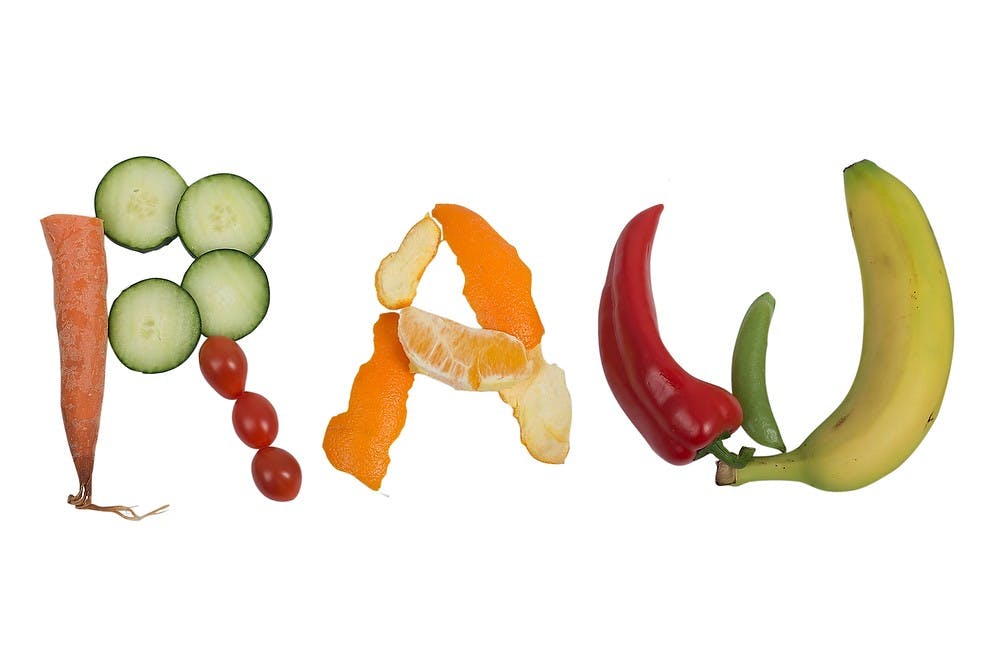Check this: We’re eating uncooked and unprocessed raw food for the month. Essentially, this includes: fruit, vegetables, nuts, seeds. This does not include: bread, pasta, rice, meat (unless raw), coffee, dairy products, most condiments. Sounds crazy, right? What sane person would do this? You may be wondering….
Uhh…Why?
Well, it hasn’t been easy. In short, it’s a challenge for both of us to see what happens when we optimize our nutritional intake for an entire month.
We’re hoping to spark conversations in our communities about food, where it comes from and what it does to our bodies.
We’re delivering content through a blog to share recipes, our experiences, interviews with engaged members of our fresh food community and information about social issues related to food.
Typically, we’re no more or less face-first in MSU Dairy Store ice cream and Crunchy’s pizza than you and yours, but we were curious as to how those foods make us feel compared to an all-raw diet. We could only find out by eliminating cooked food altogether.
How do we feel?
Incredible. Raw dishes taste delightful, and we’re free to eat as much of it as we want, completely guilt-free. Every morning we down a smoothie with somewhere around six servings of fruit.
Forget the coffee. Raw food gives us more. We’re energized, need less sleep, without stomachaches, think with clear heads and feel quicker on our feet…you get the idea.
We shrunk, too. A belt notch, to be specific.
What sucks?
But it’s not all sunshine and roses. Smells of curry chicken from our roommates taunt us every day.
Even walking past cafeterias on campus makes us salivate, dreaming of french fries and cookies.
We’re attempting to turn the tables on our attitude toward raw food. We want to move from putting up with it to choosing fresh produce instead of cooked meals.
Poor eating habits can surface at times because we’re stressed. There’s nothing like a huge plate of pasta after a tough day. Our indulgence now? Raisins.
But let’s weigh the pros and cons here.
All the benefits listed above versus sacrificing 15 minutes of pleasure tasting a juicy burger. We know we’ll regret that burger later.
Why does this matter?
Food hits us with immense ripple effects. One obvious area is our health. An investment in a proper diet now decreases our probability to contract health complications in the future.
We’ve learned an astounding amount during our challenge this month. If I eat a cooked meal, my body’s white blood cell count actually increases to process the food.
In other words, my body attacks Ramen noodles because it’s extremely nutrient-deficient as a processed, cooked food. That’s why we enter a food coma after a huge meal of pizza, chicken wings, burgers, etc. Is that stuff even real food in the first place? Where does it come from? How much of it is processed?
Because raw food comes from the ground, it only makes sense for us to give back to the earth.
Since the project’s inception, we’ve started composting with worms and it rules.
It allows us to rest easy about the pre-consumer food waste we’re accumulating—zucchini peels or the inedible pineapple top, for instance.
The worms digest the rinds and produce a casting, which is then used as fertilizer to grow more fruits and vegetables.
Uncovering the privilege of eating produce for 100 percent of our meals has been vital in our learning so far this month.
Eating raw takes a thick wallet and access to stores that provide a selection of fresh food.
Food deserts — regions without easily accessible fresh produce, often located in rural or low income areas — exist even in Lansing, so we needed to find a way to relate eating raw to those without the same resources.
Our project helped us to understand gardening, even in the winter, to put vegetables on our plates.
The Bailey Hoop House, an unheated solar greenhouse in Brody Neighborhood, and some of the Student Housing Cooperative gardens, such as the Bower House cold frame garden, thrive in the cold.
Why can’t everyone eat more raw food?
It’s expensive.
Support student media!
Please consider donating to The State News and help fund the future of journalism.
We’ve even turned to dumpster diving, a fruitful venture. After hours, some health food store dumpsters are full of discarded produce.
We pluck ‘em right from the trash, give ‘em a good wash at home and down the hatch they go.
Some items in the dumpsters definitely are unsalvageable, but food such as apples, oranges and cucumbers can be washed and peeled. It seems a bit extreme, but when we can’t afford the cost of purchasing raw food for a 24/7 diet, this option saves us cash.
Loads of suppliers toss fruits and vegetables every day, yet there are tons of folks eating Chef Boyardee for dinner. What’s with that?
It’s taken some getting used to the dirt under our fingernails, but eating raw requires a lifestyle change, not just a different diet.
We’re continually taking steps to educate ourselves and our peers about what eating raw can look like and what it could mean for our society as a sustainable way of life.
Is our challenge realistic or unreasonable?
By drawing a line in the sand this month, we are figuring out what makes sense to continue as we prepare to go back to our “regular” lives beyond the end of January.
To read more about our raw food adventures, check out our blog.
Gabriela Saldivia is a journalism junior and Colin Marshall is a recent MSU alumnus. Reach them at saldivi3@msu.edu and marsh337@msu.edu.
Discussion
Share and discuss “Raw” on social media.







